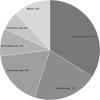Association Between Antibiotic Duration and Recurrence of Urinary Tract Infection in the Neonatal Critical Care Unit
- PMID: 38863857
- PMCID: PMC11163897
- DOI: 10.5863/1551-6776-29.3.316
Association Between Antibiotic Duration and Recurrence of Urinary Tract Infection in the Neonatal Critical Care Unit
Abstract
Objectives: Urinary tract infection (UTI) is the most common bacterial infection in infants. Current practice guidelines suggest a treatment duration of 7 to 14 days. Suboptimal therapy may increase the risk for recurrent UTIs leading to renal scarring and possibly chronic kidney disease. The primary objective is to evaluate the duration of therapy for UTIs and its association with the incidence of recurrent UTIs in a neonatal intensive care unit (NICU). The secondary objectives are to identify the risk factors and the most common organisms for recurrent UTIs.
Methods: Patients were identified via the diagnosis codes for UTIs and were included if admitted to the NICU and if they received antibiotics prior to hospital discharge. Patients were divided into 2 groups: antibiotic treatment for 7 days or fewer and antibiotic treatment for greater than 7 days.
Results: Eighty-six infants were included in the study. Twenty-six patients received antibiotics for 7 days or fewer, and 60 for more than 7 days. In the study, the median birth weight was 977 g and the median gestational age was 27.6 weeks. There was no significant difference in the rate of recurrent UTIs between the 2 groups (p = 0.66). However, in the subgroup analysis, the incidence was higher for patients receiving antibiotic therapy for fewer than 7 days versus 7 days (p = 0.03).
Conclusion: There was no difference in recurrence of UTI between treatment groups (≤7 days versus >7 days), and recurrence was seen in a higher percentage of patients with a urinary tract anomaly.
Keywords: antibiotic; duration of therapy; neonatal infection; pyelonephritis; recurrent urinary tract infection.
Copyright. Pediatric Pharmacy Association. All rights reserved. For permissions, email: membership@pediatricpharmacy.org.
Conflict of interest statement
Disclosure. The authors declare no conflicts or financial interest in any product or service mentioned in the manuscript, including grants, equipment, medications, employment, gifts, and honoraria. All authors had full access to all the data in the study and take responsibility for the integrity of the data and the accuracy of the data analysis.
Similar articles
-
Community-onset carbapenem-resistant Klebsiella pneumoniae urinary tract infections in infancy following NICU hospitalisation.J Pediatr Urol. 2017 Oct;13(5):495.e1-495.e6. doi: 10.1016/j.jpurol.2017.02.008. Epub 2017 Mar 11. J Pediatr Urol. 2017. PMID: 28341427
-
A meta-analysis of randomized, controlled trials comparing short- and long-course antibiotic therapy for urinary tract infections in children.Pediatrics. 2002 May;109(5):E70-0. doi: 10.1542/peds.109.5.e70. Pediatrics. 2002. PMID: 11986476
-
Diagnosis and management of male urinary tract infections: a need for new guidelines. Study from a French general practice electronic database.Fam Pract. 2021 Jul 28;38(4):432-440. doi: 10.1093/fampra/cmaa136. Fam Pract. 2021. PMID: 33340317
-
Adherence to European Association of Urology Guidelines and State of the Art of Glycosaminoglycan Therapy for the Management of Urinary Tract Infections: A Narrative Review and Expert Meeting Report.Eur Urol Open Sci. 2022 Aug 23;44:37-45. doi: 10.1016/j.euros.2022.07.009. eCollection 2022 Oct. Eur Urol Open Sci. 2022. PMID: 36051173 Free PMC article. Review.
-
Urinary tract infections in the elderly population.Am J Geriatr Pharmacother. 2011 Oct;9(5):286-309. doi: 10.1016/j.amjopharm.2011.07.002. Epub 2011 Aug 12. Am J Geriatr Pharmacother. 2011. PMID: 21840265 Review.
References
-
- Lai A, Rove KO, Amin S, et al. Diagnosis and management of urinary tract infections in premature and term infants. NeoReview . 2018;19(6):e337–e347.
-
- Lotem G, Yael B, Nir S, et al. Long-term follow-up of premature infants with urinary tract infection. Eur J Pediatr . 2021;180(9):3059–3066. - PubMed
LinkOut - more resources
Full Text Sources

